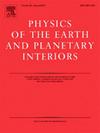Porosity and hydrous alteration of the Martian crust from InSight seismic data
IF 1.9
3区 地球科学
Q2 GEOCHEMISTRY & GEOPHYSICS
引用次数: 0
Abstract
The composition and layering of the Martian crust provide important constraints on planetary crustal evolution as well as on present-day conditions, e.g., with regard to the presence of liquid water or ice. The seismic data of the InSight mission yielded new and critical information on crustal structure at several locations on Mars. Here, we use rock physical models to investigate the range of lithologies, porosities and alteration scenarios compatible with seismic P- and S-wave velocities as well as / ratios from InSight. We find that present-day crustal porosity extends to 20–25 km depth at all sampled locations, with large Noachian impacts as main drivers for the creation of porosity, and viscous pore closure as likely agent of removal of porosity at depth, resulting in a discontinuous increase in seismic velocities. Spatially heterogeneous seismic velocities can be related to differences in porosity that could be caused by subsequent localized magmatic activity. At the InSight landing site, where seismic data indicate a four-layered crust, hydrated minerals as traces of aqueous alteration are present throughout the crust, though the water within these minerals could be fairly limited at 0.3 wt% or less. The most likely types of hydrated minerals are also consistent with a post-depositional environment that was limited in water. The velocity increase at about 10 km depth beneath InSight can either be attributed to a change in composition from felsic to basaltic, or to a change in porosity by the deposition of Utopia ejecta. A felsic component to the crust, e.g. due to impact-generated buoyant partial melts, can accordingly not be excluded, but would not be present globally. Seismic and geological constraints for the layer at approximately 200 m to 2000 m depth beneath the lander strongly favor basaltic Noachian sediments saturated with a mixture of up to 10 % ice and brine. However, the lateral extent of this present day aquifer is not constrained by the available data.

洞察号地震数据显示的火星地壳孔隙度和含水蚀变
火星地壳的组成和分层对行星地壳的演化以及目前的条件,例如液态水或冰的存在,提供了重要的限制。洞察号任务的地震数据为火星上几个地点的地壳结构提供了新的关键信息。在这里,我们使用岩石物理模型来研究与InSight地震P波和s波速度以及vP/vS比兼容的岩性、孔隙度和蚀变情景范围。我们发现,在所有采样点,现今地壳孔隙度延伸至20-25 km深度,大的诺亚亚影响是孔隙度产生的主要驱动因素,而粘性孔隙封闭可能是深度孔隙度去除的因素,导致地震速度不连续增加。空间非均质地震速度可能与孔隙度差异有关,孔隙度差异可能由随后的局部岩浆活动引起。在洞察号的着陆点,地震数据显示有四层地壳,水合矿物作为水蚀变的痕迹存在于整个地壳中,尽管这些矿物中的水含量可能相当有限,只有0.3 wt%或更少。最可能的水合矿物类型也与沉积后的水有限环境相一致。在“洞察号”地下约10公里深处,速度的增加可以归因于组成从长英质到玄武岩的变化,也可以归因于乌托邦喷出物沉积导致孔隙度的变化。因此,不能排除地壳中的英质成分,例如由于撞击产生的浮力部分熔体,但不会在全球范围内存在。在着陆器下约200米至2000米深度的地层中,地震和地质条件的限制强烈支持玄武质诺阿奇亚沉积物,其中饱和了高达10%的冰和盐水混合物。然而,目前这一含水层的横向范围不受现有数据的限制。
本文章由计算机程序翻译,如有差异,请以英文原文为准。
求助全文
约1分钟内获得全文
求助全文
来源期刊

Physics of the Earth and Planetary Interiors
地学天文-地球化学与地球物理
CiteScore
5.00
自引率
4.30%
发文量
78
审稿时长
18.5 weeks
期刊介绍:
Launched in 1968 to fill the need for an international journal in the field of planetary physics, geodesy and geophysics, Physics of the Earth and Planetary Interiors has now grown to become important reading matter for all geophysicists. It is the only journal to be entirely devoted to the physical and chemical processes of planetary interiors.
Original research papers, review articles, short communications and book reviews are all published on a regular basis; and from time to time special issues of the journal are devoted to the publication of the proceedings of symposia and congresses which the editors feel will be of particular interest to the reader.
 求助内容:
求助内容: 应助结果提醒方式:
应助结果提醒方式:


